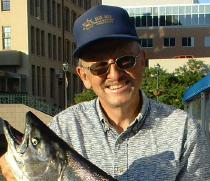How do I use my G.P.S
How do I use my G.P.S
By Lake Michigan fishing charter Capt. Jim Hirt
Finding and consistently producing fish is the goal of every fisherman every trip out on the water. The question is how can it be done? This article will communicate the importance of G.P.S. for filling the cooler and returning home safely.
Questions
Should you have a question please e-mail me from my Blue Max website contact us page. Read all my articles and see video fish reports at http://www.jimhirt.com
The Tool
For those of you not familiar with G.P.S. I will give you a brief overview of the product. Global Positioning System is a series of satellites that circle the earth each with a distinctive signal. This signal is sent by the satellites to a receiver. The receiver will then tell you your location on the earth in longitude and latitude. The accuracy of this information is within 15 feet or less.
The Cost
The price of a G.P.S. can range from $80 to several thousand dollars. The more expensive units will offer more graphic information that makes them easier to use, although the accuracy is the same. My experience with both high and low priced units tells me I do not need an expensive unit. The key to successful operation is learning how to apply the extensive information available.
G.P.S. and Safety
The question is how do I use my location as provided by G.P.S. to fill the cooler and return home safely? Let’s start with safety. You should always enter in the memory of your unit the spot where you put your boat in the water. We will call this your home waypoint. Most units will store 500 or more waypoints. Assuming there is no shallow water or obstacles like land in your path, use your home waypoint and compass to find your way home. Fog, darkness or bad weather does not effect the operation of this unit. In the event of an emergency you could call someone with your coordinates and they would know where to find you.
G.P.S. and finding fish
In the more sophisticated units a map showing your position with the depth of water at your location is displayed. The use of this information is critical when working bottom structure for fish.
There are many ways to use G.P.S. for finding fish. On my boat we log the coordinates of every fish caught on a sheet of paper. These coordinates are used to return to the same spot day after day. After a fish hits a lure it makes perfect sense to turn the boat around to try the same spot again. Many times we will get another fish on immediately as we pass the same location. When no additional fish are taken, we will circle in that area using the original coordinates as the center of our search.
Save the spot
I usually enter one of the areas where action has been very good as a waypoint in the G.P.S. for future trips. Working with latitude and longitude numbers takes a little practice, stay with it the work is worth it. There are chart plotter units that draw a line showing the path of the boat on the display screen to simplify this process. As I mentioned earlier a chart plotter G.P.S. with a map chip for your area will give you your position relative to water depth, land features and harbor entrances. I use the water depth when I follow a bottom contour for fish holding near the bottom. Lake trout are known for staying near the bottom. This technique is very effective for them.
G.P.S. save tackle
On the Great Lakes we often fish in areas where wrecks are located. The location of wrecks entered in the G.P.S. will save a lot of lost tackle. It will allow you to fish near wrecks without the fear of hanging up on them.
G.P.S. a must have
I like to enter the location of schools of bait fish you see on the locator when under power heading out to a spot or trolling for further investigation.
On a trip that starts before daylight, you must have G.P.S. to pin point the location of yesterday’s hot first light action.
I could go on and on about the importance of knowing precisely where you are and where you want to be. Some would consider G.P.S. a luxury or not needed. I find the information this unit supplies as invaluable and you will too. Good luck. Jim charters out of Milwaukee, WI. with Blue Max Charters. He can be reached at 414-828-1094 or visit his web site at http://www.bluemaxcharters.com Copyright© 2013, James J. Hirt, All Rights Reserved .





